
Tatra is a Czech vehicle manufacturer from Kopřivnice. It is owned by the TATRA TRUCKS a.s. company, and it is the third oldest company in the world producing motor vehicles with an unbroken history. The company was founded in 1850 as Ignatz Schustala & Cie. In 1890 the company became a joint-stock company and was renamed the Nesselsdorfer Wagenbau-Fabriksgesellschaft. In 1897, the Nesselsdorfer Wagenbau-Fabriksgesellschaft produced the Präsident, which was the first factory-produced automobile with a petrol engine to be made in Central and Eastern Europe. In 1918, the company was renamed Kopřivnická vozovka a.s., and in 1919 it changed from the Nesselsdorfer marque to the Tatra badge, named after the nearby Tatra Mountains on the Czechoslovak-Polish border.
Matra was a French industrial conglomerate. During its years of operation, it was engaged in a wide range of business activities, primarily focused around automobiles, bicycles, aeronautics and weaponry.
The Locomobile Company of America was a pioneering American automobile manufacturer founded in 1899, and known for its dedication to precision before the assembly-line era. It was one of the earliest car manufacturers in the advent of the automobile age. For the first two years after its founding, the company was located in Watertown, Massachusetts. Production was transferred to Bridgeport, Connecticut, in 1900, where it remained until the company's demise in 1929. The company manufactured affordable, small steam cars until 1903, when production switched entirely to internal combustion-powered luxury automobiles. Locomobile was taken over in 1922 by Durant Motors and eventually went out of business in 1929. All cars ever produced by the original company were always sold under the brand name Locomobile.
Internal combustion engine cooling uses either air or liquid to remove the waste heat from an internal combustion engine. For small or special purpose engines, cooling using air from the atmosphere makes for a lightweight and relatively simple system. Watercraft can use water directly from the surrounding environment to cool their engines. For water-cooled engines on aircraft and surface vehicles, waste heat is transferred from a closed loop of water pumped through the engine to the surrounding atmosphere by a radiator.
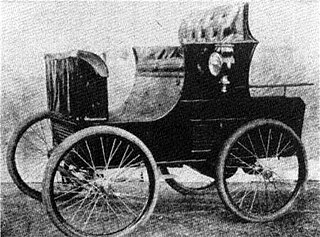
Altham was an automobile manufactured from 1898 to 1899, in Fall River, Massachusetts, United States. It was designed by George J. Altham, and manufactured by Altham International Motor Car Company, which was based in Boston, Massachusetts, United States.
Liquid air is air that has been cooled to very low temperatures, so that it has condensed into a pale blue mobile liquid. It is stored in specialized containers, such as vacuum flasks, to insulate it from room temperature. Liquid air can absorb heat rapidly and revert to its gaseous state. It is often used for condensing other substances into liquid and/or solidifying them, and as an industrial source of nitrogen, oxygen, argon, and other inert gases through a process called air separation.
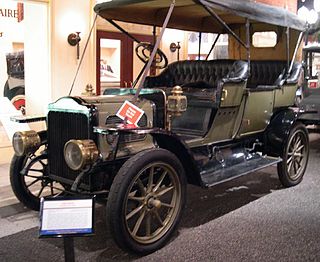
A steam car is a car (automobile) propelled by a steam engine. A steam engine is an external combustion engine (ECE), whereas the gasoline and diesel engines that eventually became standard are internal combustion engines (ICE). ECEs have a lower thermal efficiency, but carbon monoxide production is more readily regulated.

Development of the automobile started in 1672 with the invention of the first steam-powered vehicle, which led to the creation of the first steam-powered automobile capable of human transportation, built by Nicolas-Joseph Cugnot in 1769. Inventors began to branch out at the start of the 19th century, creating the de Rivaz engine, one of the first internal combustion engines, and an early electric motor. Samuel Brown later tested the first industrially applied internal combustion engine in 1826.
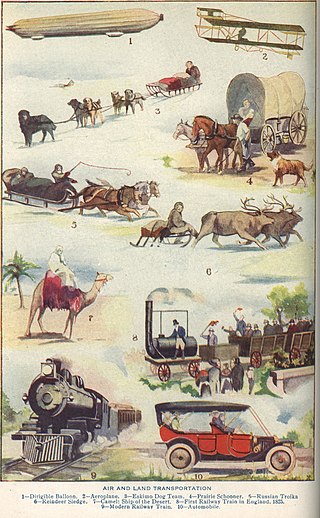
Mode of transport is a term used to distinguish between different ways of transportation or transporting people or goods. The different modes of transport are air, water, and land transport, which includes rails or railways, road and off-road transport. Other modes of transport also exist, including pipelines, cable transport, and space transport. Human-powered transport and animal-powered transport are sometimes regarded as their own mode, but never fall into the other categories. In general, transportation is used for moving of people, animals, and other goods from one place to another. Means of transport, on the other hand, refers to the transport facilities used to carry people or cargo according to the chosen mode. Each mode of transport has a fundamentally different technological solution, and some require a separate environment. Each mode has its own infrastructure, vehicles, transport operators and operations.Transportations helps in the better utilisation of the resources of the backyard areas by linking them with the more advanced areas. It aids in the process of industrialisation and urbanization.

Larz Anderson Auto Museum is located in the Anderson Carriage House on the grounds of Larz Anderson Park in Brookline, Massachusetts and is the oldest collection of motorcars in the United States.
The following outline is provided as an overview of and topical guide to automobiles:
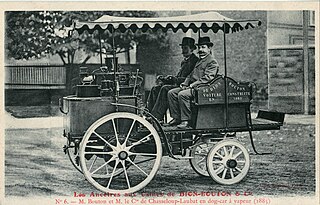
Count Charles-François Gaston Louis Prosper de Chasseloup-Laubat was a French aristocrat and race car driver.

A car, or an automobile, is a motor vehicle with wheels. Most definitions of cars state that they run primarily on roads, seat one to eight people, have four wheels, and mainly transport people, not cargo.

The history of steam road vehicles comprises the development of vehicles powered by a steam engine for use on land and independent of rails, whether for conventional road use, such as the steam car and steam waggon, or for agricultural or heavy haulage work, such as the traction engine.
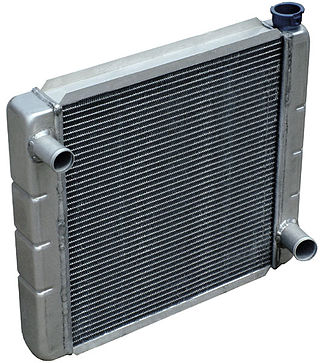
Radiators are heat exchangers used for cooling internal combustion engines, mainly in automobiles but also in piston-engined aircraft, railway locomotives, motorcycles, stationary generating plant or any similar use of such an engine.
A liquid nitrogen vehicle is powered by liquid nitrogen, which is stored in a tank. Traditional nitrogen engine designs work by heating the liquid nitrogen in a heat exchanger, extracting heat from the ambient air and using the resulting pressurized gas to operate a piston or rotary motor. Vehicles propelled by liquid nitrogen have been demonstrated, but are not used commercially. One such vehicle, Liquid Air, was demonstrated in 1902.

Automotive air conditioning systems use air conditioning to cool the air in a vehicle.
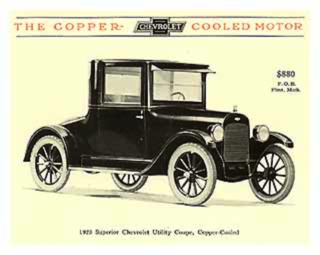
The 1923 Chevrolet Series M Copper-Cooled was an automobile made to be completely air-cooled by Chevrolet in 1923. It was designed by Charles F. Kettering, head engineer of Delco, the General Motors research division wing in Dayton, Ohio. The automobile used a body style from its predecessor, but incorporated an air-cooled engine. Air cooling, as opposed to water-based cooling, was much more practical in a sense because it did not require a radiator, nor the piping that came with it. Although air cooling was not new to the time period, it was new to engines of that scale. The Copper-Cooled Chevrolet was in fact a feasible project; however, the final product did not live up to the standards that Kettering had imagined. The car dangerously overheated in hot weather, and posed a safety hazard to the drivers. Only a few made it to the sales floor, only to be recalled and destroyed by Chevrolet. The 1923 Chevrolet Series M Copper-Cooled consumed extensive amounts of resources to develop and was a failure in the end. The engine was manufactured as an alternative to the Franklin which also used an in-line air-cooled engine.












